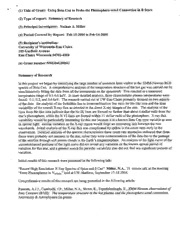
NASA Technical Reports Server (NTRS) 20050184190: Using Beta Cen to Probe the Photosphere-wind Connection in B Stars PDF
Preview NASA Technical Reports Server (NTRS) 20050184190: Using Beta Cen to Probe the Photosphere-wind Connection in B Stars
(1) Title of Grant: Using Beta Cen to Probe the Photosphere-wind Connection in B Stars (2) Type of report: Summary of Research (3) Principal Investigator: Nathan A. Miller (4) Period Covered by Report: Feb-15-2004 to Feb-14-2005 (5) Recipient’s institution: University of Wisconsin-Eau Claire 105 Garfield Avenue Eau Claire Wisconsin 54702-4004 (6) Grant number NNG04GD06G Summary of Research In this project we began by identifying the large number of emission lines visible in the =-Newton RGS spectra of Beta Cen. A comprehensive analysis of the temperature structure of the hot gas was carried out by simultaneously fitting the data fi-om all the instruments on the spacecraft. This resulted in a measured temperature range of 0.1-0.6 keV. In more detailed analysis, three characteristic plasma temperatures were found: 0.1,0.2, and 0.6 keV. The research carried out at UW-Eau Claire primarily focused on two aspects of the data: the analysis of the forbidden line to intercombination line ratio for He-like ions and the time variability of the overall X-ray flux as detected in the direct X-ray images of the star. The analysis of the lines fiom He-like ions indicate that the Ne IX lines are formed no farther than about 4 stellar radii fiom the star’s photosphere, while the N VI lines are formed within 11 stellar radii of the photosphere. X-ray flux variability would be particularly interesting for this star because it is a known Beta Cep-type variable as seen in optical light: similar variation in the X-ray region would forge an interesting link between the two wavebands. Initial analysis of the X-ray flux was complicated by spikes in the count rates early in the observation. Detailed analysis of the spectral characteristics these count rate anomalies indicated that these flares were probably not intrinsic to the star, rather they were contaminations of the data due to the passage of the satellite through soft proton clouds in the Earth’s magnetosphere. An analysis of the light curve of the uncontaminated portions of the light curve did not reveal any variation on the known optical period of variation for this star, and a general search for periodic variability also did not find any significant periods of variation. Initial results of this research were presented in the following talk: “Recent High Resolution X-Ray Spectra of Spica and p Cen” Miller, N.A., 15 minute talk at the meeting “From Photospheres to Vinfinity” held at UW-Madison, September 17-18 2004. Comprehensive results of this research are being presented in the following article: Raassen, A.J.J., Cassinelli, J.P., Miller, N.A., Mewe, R., Tepedelenlioglu, E., XMM-Newton observations of Beta Centauri (BIIII): The temperature structure in the hot plasma and the photosphere-wind connection, Astronomy & Astrophysics (in press). Final Inventory Report of Federally-Owned Property No purchases were made of equipment costing in excess of $5000. This project did not result in the acquisition of federally-owned property. Subject Inventions Final Report: This research did not involve the creation of patentable inventions. Respectfully submitted, H " -91 Prof. Nathan A. Miller Dept. of Physics & Astronomy University of Wisconsin-Eau Claire
